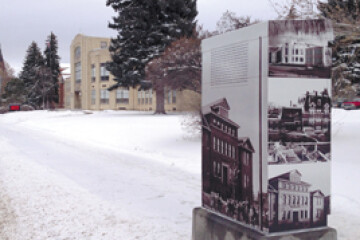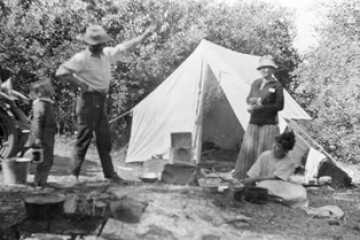Revitalization comes to Gallatin County High School
Revitalization of another historic downtown building is slated for the fall of 2014. The Gallatin County Free High School, located at 308 West Main Street and known locally as East Willson School, will be adaptively reused into residential condominium units.
Though Montana Territory made elementary education compulsory as early as 1883, it took another decade to make a high school education available to all pupils. In 1899, the Montana Legislature passed a new law giving voters the option to create one free high school per county by consolidating funding from all of the districts in the county.
After Gallatin County voters selected Bozeman as the high school’s location, classes began in temporary quarters in the fall of 1899. On May 4, 1901, the editors of the Avant Courier newspaper rallied voter support for a $30,000 bond at 4% interest to build permanent facilities. The editors noted the enrollment of more than 200 “bright, deserving pupils,” and that “the present quarters- the old skating rink structure remodeled, is wholly unsuitable for the purpose- there are no two opinions as to that.”
Voters approved the bond on May 25, 1901, and the Trustees met a month later to discuss a building location. The Courier reported that, “There were a dozen or more propositions, offering sites in various portions of the city, the plats of ground varying from 10 to 20 city lots, and the prices running from a few hundred dollars to $4,000, according to the location and the ground.”
The building site remained uncertain through the fall of 1901, when Gallatin County High School relocated for the fall term to a building at the south east corner of West Main Street and Third Avenue (now the location of Holy Rosary Catholic Church). The academy was a block from Irving School (now the site of Emerson School), which stood on the 200-300 of West Babcock Street.
In early January 1902, the Trustees spurned less expensive land offers to purchase a permanent building site across South Third Avenue, at the south west corner of West Main and Third. They paid Nelson and Ellen Story, whose impressive 1887 mansion occupied the opposite end of the two-block parcel, $2,500 for the property. Story agreed to excavate the site as soon as the weather was favorable and may have donated the foundation.
The school’s National Register nomination mistakenly identified George Hancock as the building’s architect. This is proved incorrect by invitations to bid on the construction project published in newspapers by Helena architect C.S. Haire. Haire completed the majority of the design work before the site was chosen, for on January 18, 1902, the job was awarded to the construction firm of Davitt and Vreeland of Bozeman, who offered the lowest bid of $25,500.
Haire’s original drawing set, on file at MSU’s Special Collections and Archives, reveals a Classical Revival style building set on a high cut sandstone foundation. The Main Street façade featured a central two-and-one-half story central block, flanked on either side by subordinate two story blocks set slightly back from the central portion. Built of red brick, with terra cotta detailing and sandstone windowsills and window headers, the design included a pedimented dormer and fan light in the tympanum set in the center of a hipped roof. Rectangular window openings on the ground floor became arched on the second floor and square in the third story in the central bay.
A wide sandstone staircase lead to the Main Street entrance, which was trimmed in cut sandstone. A central hallway ran parallel to Main Street with a staircase at the east and west ends which provided access to all four floors of the building.
On December 12, 1902, the Courier reported construction nearly complete and described the building in detail, noting “The interior of the building is finished in oak with stamped metal wainscoting, and hard maple floors. The basement contains the boiler room, toilet rooms and the gymnasium. On the first floor [is] the Physics laboratory and the Botanical laboratory. Four rooms on the first floor are not used at present, but… will be needed as a recitation room after the new class enters from the graded schools in January.
The second floor is the principal floor at present. Here are the office, the library, the assembly hall and three recitation rooms. The office is on the north side of the building adjacent to the Library. The assembly hall on the south side of the building is a fine large room which will seat between 200 and 250. Connected with the assembly hall are two commodious cloak rooms. The art room occupies the third floor. This room is fitted specially for this purpose, receiving its light from the north.”
Gallatin County filled the high school to overflowing within a decade. In February 1913, the Trustees met with local architect Fred Willson to design an addition to the south of the existing school. Willson, born in Bozeman in 1877, and educated at Colombia University and in Europe, worked briefly for C.S. Haire before starting his own firm in Bozeman in 1910.
Willson’s appointment book reveals that the 35 year old bachelor, who married in October 1913, had a penchant for working late into the night before a deadline. On April 18, 1913, Willson noted “routine office day. Evening and night 8:30pm to 3am on main Gall. School sketches.” The Bozeman Daily Chronicle newspaper reported that the Trustees accepted plans for the addition the next day.
Following bond approval by voters, Willson recorded that excavation for the addition began on May 20. Willson’s diary reveals work on the design almost every day between May 22 and June 6. The Trustees opened construction bids on August 14, 1913, and the construction firm of Gangon of Billings commenced construction in the first week of September.
Willson’s design introduced a new north-south hallway through the building, which divided the first floor laboratories and second floor study hall and created space on either side of the new hallway for classrooms. The addition mimicked the symmetry of the original building and retained the floor heights set by Haire in 1901. Different window sizes reflected the uses in the interior spaces. Willson utilized new materials where possible, including metal panels for fascia in the eaves rather than the bead board fascia with brackets and dentils used in the eaves of the 1901 building.
In February 1914, the Courier reported construction of the second floor auditorium at the south end of the addition nearly complete. The auditorium, which sat 500 people, received copious amounts of natural light from the huge windows on the east side of the structure, a skylight “probably fifty by thirty feet,” and prismatic glass used in the west-facing windows to deflect light to the ceiling above. The Courier noted that “The stage is large and wide. It slopes down toward the assembly floor, though it is raised probably four feet above it. Students may enter this assembly hall by coming into the new addition from the south, or by entering through the old portions of the high school on Main.”
The Courier further described the addition by writing, “The basement of the new part will be fitted with manual training rooms, shops and the like while the ground floor below the assembly room will be fitted with admirably arranged recitation rooms.”
A flat roof hidden behind a Mission Revival style curved parapet capped the addition’s southern entrance and stage area. Willson may have made this design choice in an effort to provide sufficient ceiling height in the backstage area for elevated dressing rooms and the gear used to move stage props.
The Courier reported that the Townsend-Gallatin debate, “scheduled for that fearsome day, Friday, the Thirteenth of February [1914],” would be the first event in the auditorium. The main floor classrooms were finished in time for classes beginning in the fall of 1914.
The high school and the Story Mansion occupied opposite ends of the 300-400 block of West Main Street in this configuration for the next 20 years. In 1935, voters approved $450,000 in bonds to match Public Works Administration funding to construct an addition to the west of the 1901 school. In supporting approval of the bonds, the September 18, 1935, Gallatin High newspaper noted that “750 students now crowd into a structure originally meant for only 450.”
Willson designed the 1935 addition, really an entirely new structure, in the Streamline Moderne style. The entire complex was renamed Willson School in honor of Fred Willson, following his death in 1958. The 1901 and 1913 portions of East Willson were shuttered in the late 1990’s when structural evaluations found the building insufficiently rated for seismic activity as an educational facility.
The 1935 portion of the complex is now used by the school district for auditorium space and administrative offices, and will remain in the school district’s ownership. The Trustees have agreed to sell the 1901 and 1913 portions of the Gallatin County Free High School for adaptive reuse by a private investor. The building will be modified in a way that retains the essence of the school’s architecture while enabling new use of the building. Parking will be located in the basement and up to 18 residential condominium units, in one, two and three bedroom layouts, will be located on the main, second and third floor of the structures.




